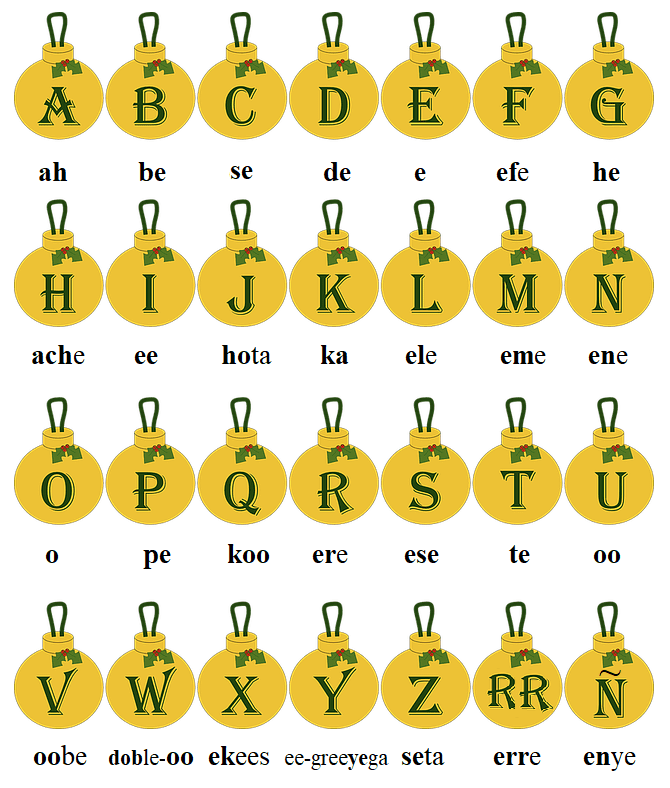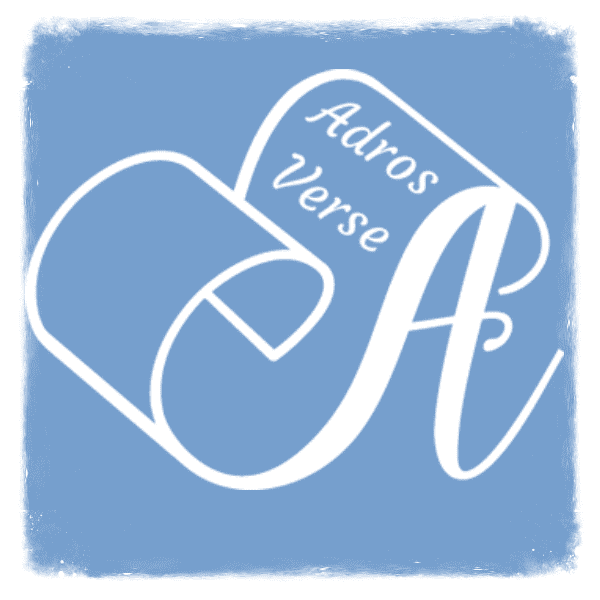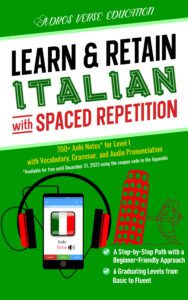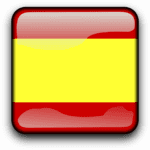In this first lesson, we will study the Spanish Alphabet. Luckily, Spanish uses the Latin letters used in English with only a few differences in pronunciation. Spanish, unlike English, is a phonetic language, meaning that you should be able to pronounce any written word without the need for a dictionary.

Table of Contents
- Spanish Alphabet
- Vowels
- Pronounced & Silent Letters in Spanish Alphabet
- Double Consonants
- Spanish in Spain vs Spanish in Latin America
Spanish Alphabet
Start with the Spanish alphabet in the table below and use your Anki cards to anchor what you learned via spaced-repetition exercises.
| Spanish Letter | English Pronunciation(1) | Notes | |
| A | a | ah | like “a” in “father” |
| B | b | be | equivalent to English “b” but softer |
| C | c | se | sounds like English “k” and like English “s” only before “e” or “i”(2) |
| CH | ch | che | like “ch” in cheese |
| D | d | de | equivalent to English “d” with tongue slightly forward like “th” in “then” |
| E | e | e | like “e” in “bet” or “a” in “say” (without the final “y”) |
| F | f | ef-e | equivalent to English “f” |
| G | g | he | sounds like “g” in “get,” and like “h” in “hero” only before “e” or “i” |
| H | h | ach-e | silent letter like “h” in “hour” |
| I | i | ee | like “ee” in “see” or “i” in “marine” |
| J | j | ho-ta | like “h” in “hero” but may sound harsher by some Spanish speakers |
| K | k | ka | equivalent to English “k” |
| L | l | el-e | equivalent to English “l” but softer |
| LL | ll | ely-e | like “y” in “yes,” or in some countries, it sounds more like “j” in “judge” |
| M | m | em-e | equivalent to English “m” |
| N | n | en-e | equivalent to English “n” |
| Ñ | ñ | eny-e | like “ni” in “onion” or “ny” in “canyon” |
| O | o | o | equivalent to English “o,” but can be shorter when not stressed |
| P | p | pe | equivalent to English “p” |
| Q | q | koo | always followed by “u” to form “qu” which sounds like English “k” |
| R | r | er-e | like English “r” but rolled with a single flap against the upper palate |
| RR | rr | er-re | strongly trilled “r” sound with multiple flaps against the upper palate |
| S | s | es-e | equivalent to English “s” |
| T | t | te | like “t” in “table” |
| U | u | oo | like “oo” in “food” |
| V | v | oo-be(3) | pronounced exactly like the letter “b” |
| W | w | dob-le oo(4) | only exists in loan words, mostly pronounced as English “w” |
| X | x | ek-ees | like “ks” in “socks,” and in a few exceptions pronounced like “h” in “hero,” e.g., “México” |
| Y | y | ee-gree-ye-ga(5) | like “y” in “yes,” or in some countries, it sounds more like “j” in “judge,” with two exceptions: At the end of a word, it is considered a vowel, e.g., “rey” (king) and pronounced as English “y” in “say.”If used as a vowel meaning “and,” it is then pronounced like “ee” in “see.” |
| Z | z | se-ta(6) | pronounced exactly like the letter “s” |
(2) In Spain, “c” before “e” or “i” is pronounced like “th” in “theta.”
(3) Also called “ve corta,” “ve chica,” or “ve pequeña.”
(4) Also called “doble ve” or “doble uve” in some parts of Latin America, and “uve doble” in Spain.
(5) Alternatively, the synonym “ye” has been recommended by the Real Academia Española (RAE), but adoption has been slow.
(6) In Spain, “z” is called “the-ta,” and is always pronounced like “th” in “theater.”
Further Notes on Spanish Alphabet Pronunciation
In the table above, “ch,” “ll,” and “rr” are treated as single letters.
The Real Academia Española (RAE), the institution that sets the standard for the Spanish language, decided in 2010 that “ch” and “ll” should no longer be considered distinct letters.
The letters “k” and “w” are only found in foreign words used in Spanish.
The letters “b” and “v” have identical sounds in Spanish, which are close to the English “b” but with less pressure on the lips and with less aspiration. The letter “v” is called “uve” (pronounced “oo-be”) or “ve corta” (pronounced “be cor-ta”).
The Letter “r” in Spanish
The letter “r” sounds like a strongly trilled “r” (identical to “rr”) when it is at the beginning of a word or after “l,” “n,” or “s,” e.g., “rojo” (red) sounds like “rro-ho” and “deshonra” (dishonor) sounds like “des-on-rra,” where the stressed syllable in the pronunciation script is in bold.
Vowels
The vowels in Spanish are “a,” “e,” “i,” “o,” and “u.” The letter “y” is considered a vowel when used as a conjunction meaning “and,” e.g., “Adán y Eva” (Adam and Eve) where “y” is pronounced “ee” as in “beef.” The letter “y” is also considered a vowel at the end of a word, e.g., “rey” (king), where it is pronounced as English “y” in “ray” or “say.”
Every vowel is pronounced separately, and each with its alphabetical sound. Thus, there are no diphthongs in the English sense.
Pronounced & Silent Letters in Spanish Alphabet
Every letter is pronounced. There are no silent letters such as “b” in “lamb” or “l” in “walk.” There are only two exceptions to this rule:
- The letter “h” is silent, e.g., “hola” pronounced “o-la,” unless it is combined with “c” to form the sound “ch” as in “cheese.”
- The letter “u” is silent in two cases:
- The letter “u” is always silent after “q,” e.g., “querer” (to want), pronounced“ke-rer” and not “kwe-rer.”
- The letter “u” is silent after “g” if it is followed by “e” or “i,” e.g., “guitarra” (guitar) is pronounced “gee-ta-rra” and not “gwee-ta-rra.” An exception is made when the “u” in “gue” or “gui” has a dieresis “ü,” in which case the “güe” and “güi” sounds are pronounced as “gwe” and “gwee,” respectively, e.g., “argüir” (to argue). If the “gu” is not followed by “e” or “i,” it is then pronounced as “gw,” e.g., “guardar” (to keep) is pronounced “gwar-dar.”
Double Consonants
The only case of a double consonant that one must be aware of is “cc,” as in words like “accidente”(accident). In such cases, one “c” is hard (k-sound) and the other soft (s-sound), in a similar fashion to the English pronunciation. Note that “rr” and “ll” are treated as single letters, not double consonants.
A much less common double-consonant is “nn,” usually found in words having the prefix “in-,” as in “innavegable” (unnavigable), “perenne” (perennial), and very few more words.
Spanish in Spain vs Spanish in Latin America
Throughout this site and the audio accompanying the Anki cards associated with the lessons, we will focus on Latin American Spanish pronunciation, in general, rather than Spanish from Spain. Although Spanish in Spain and Spanish in Latin America have their differences, most of the grammar and vocabulary remain unchanged. Thus, this site is useful for learners of both variations of the language. When it comes to regional differences in vocabulary and pronunciation, we generally focus on Latin American Spanish without limiting ourselves to a specific country or region.
Next: Syllable Stress in Spanish Words
Other Lessons in Level I:










